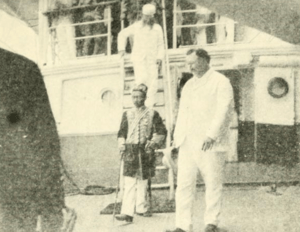Kiram–Bates Treaty facts for kids
| Treaty between the United States of America and the Sultanate of Sulu | |
|---|---|
| Signed | 20 August 1899 |
| Location | Jolo, Sultanate of Sulu |
| Negotiators |
|
| Signatories | |
| Languages |
|
| On 02 March 1904, President Theodore Roosevelt declared the Kiram-Bates Treaty null and void. | |
The Kiram–Bates Treaty, also known as the Bates Treaty, was an important agreement. It was signed between the United States and the Sultanate of Sulu. This happened during the Philippine–American War. The main goal of the treaty was to keep the Sulu Sultanate from joining the war. This allowed the United States to focus its soldiers in northern Luzon.
Even though it's called a "treaty," it was officially an "agreement." This was a smaller type of deal under international rules. U.S. law did not require the U.S. Senate to approve an "agreement."
Why the Treaty Was Needed

Before this, Spain had a peace treaty with the Sulu Sultanate in 1878. Spain was allowed to have a small military base on Siasi Island and in Jolo town. When the Philippine–American War started, the U.S. military had limited soldiers. They needed to send most of them to the northern Philippines.
To prevent fighting with the Moro people in the Sulu Archipelago, the U.S. made a deal. Brigadier General John C. Bates represented the United States. He worked to create an agreement with the Sulu Sultanate.
General Elwell Stephen Otis sent orders to General Bates. Otis thought the Sultan ruled all Moros. He believed Bates just needed to get the Sultan to agree to transfer the old Spanish treaty.
However, Bates learned something important. Spain had only "suzerainty" over the Sultanate of Sulu, not "sovereignty."
- Suzerainty means one state has some control over another, but the lesser state is still mostly independent. It's like a protectorate.
- Sovereignty means one state has complete power and authority over another.
This meant Spain didn't have full power to give the Sulu Archipelago to the U.S. in the Treaty of Paris. Bates realized a new treaty was needed. He learned the Sultan needed money and wanted U.S. protection for economic growth. Bates used the USS Charleston, a modern warship, to impress the Sultan and his chiefs (called datus).
What the Treaty Said
The Bates Treaty replaced the old Spanish agreement. It included several key points:
- The U.S. would recognize its control (sovereignty) over Sulu and its lands.
- The U.S. and the Sultanate of Sulu would respect each other.
- The Moro people would keep their self-rule (autonomy).
- The U.S. would not interfere with Moro religion and customs.
- The U.S. promised not to sell Jolo or any other island in the Sulu Archipelago to another country without the Sultan's permission.
Also, Sultan Jamal ul-Kiram and his datus would get monthly payments. In return, they would fly the American flag. They also allowed the U.S. to use land on the islands.
The Sultan did not want to accept U.S. control. But his prime minister, Hadji Butu Abdul Bagui, and two important datus, Datu Jolkanairn and Datu Kalbi, convinced him. Hadji Bagui wanted to avoid another war. He knew fighting the U.S. would be very difficult.
There was a big mistake in the treaty's translation. The Tausug version (the local language) said: "The support, aid, and protection of the Jolo Island and Archipelago are in the American nation." But the English version said: "The sovereignty of the United States over the whole Archipelago of Jolo and its dependencies is declared and acknowledged." The word "sovereignty" was not in the Tausug version at all.
What Happened After the Treaty

The Bates Treaty did not last long. Once the United States finished fighting in northern Luzon, they ended the treaty. This happened on March 2, 1904. The U.S. claimed the Sultan had not stopped Moro resistance. They also said the treaty made it hard to govern the area.
Payments to the Sultan and his datus were stopped. However, the U.S.-Philippine Commission later restarted these payments in November 1904.
General Bates later admitted that he never planned for the treaty to last. He said it was just a temporary way to gain time. This allowed the U.S. to defeat the forces in northern Luzon first.

